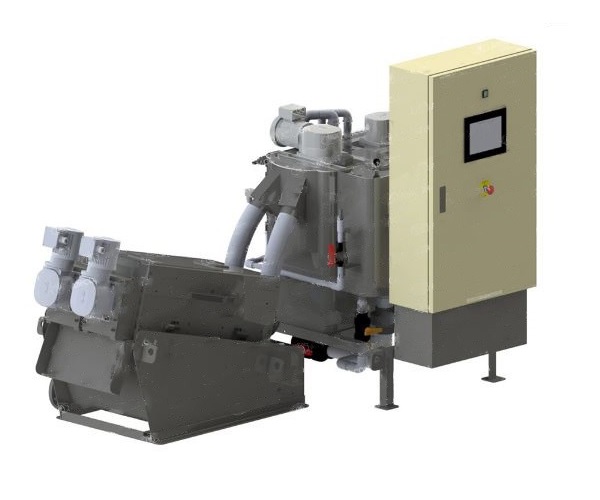Screw dehydrator
The screw dehydrator is intended for mechanical dehydration of sediments of domestic, industrial and city wastewater. It is used for dehydration of any types of sludge formed in the system of treatment of domestic, industrial and agricultural effluents at the enterprises of food, pulp and paper, textile, chemical, oil refining and other industries.
A screw dehydrator is installed on the sites of treatment plants with a dry matter productivity of the initial sludge up to 200 kg/h and with sewage sludge with a pH of 6.0-9.0. Dewatered sludge, depending on the composition of wastewater, at a concentration of suspended solids from 2000-50000 mg/l has a humidity of 67-80%. The built-in zone of thickening of the screw dehydrator allows to dewater a sludge with concentration of the suspended solids from 2000 mg/l due to what there is no need for installation of a sludge compactor.The design of the screw dehydrator prevents clogging of the drum, thanks to which, the need for large volumes of flushing water disappears. Reliability of a design is caused by absence in device of high-loading and high-speed units.
Order a screw dehydrator
The screw dehydrator has a low level of vibration and noise during operation, it consumes less electricity than any other dewatering system used for industrial wastewater treatment, which is a priority in the context of sustainable development and energy saving and significantly reduces operating costs. It works in the automatic mode on level sensors or on the timer and does not demand constant presence of the operator who serves of wastewater treatment station. The screw dehydrator is equipped with drive mechanisms, system of regulation of speed of rotation of screws and a mixer.All electrical sensors and actuators have a high level of protection against moisture and corrosion influence of ambient air. The light weight and dimensions of the screw dehydrator allow to place it compactly on the territory of treatment plants. Screw dehydrator is made of stainless steel of various sizes.
The screw dehydrator consists of a dewatering drum with an electric drive, a flushing unit, a technological and dosing tank, as well as a tank for flocculant equipped with an electric mixer. In the technological tank located at the bottom of the installation, there is a dosing pump and a pump for mixing the initial sludge. The flocculation and dosing tanks are located above the technological tank and are connected via a V-shaped overflow. The level of the initial sludge in the dosing tank is regulated by the overflow coupling, which is connected to the technological tank.
The main working part of the screw dehydrator is a dewatering drum, which is a set of movable and immovable rings assembled on a supporting frame, inside which there is an srew with a variable pitch. In the inlet part of the drum (thickening zone) the gaps between the rings are larger than in the next zone (pressing zone). The pitch of the srew turns gradually decreases to the pressing zone. The screw of the dehydration drum is driven by a gear motor with low speed. Under the dehydration drum is a tray for receiving and discharging the filtrate. The screw dehydrator can be equipped with rake screens of fine cleaning which are established directly on the line of an entrance of an initial sludge in technological tank. The presence of these screens allows the filtration of sludge to prevent large and fibrous inclusions in the pumps and dewatering drums of the dehydrator, which allows the sludge to be fed directly from settling tanks or aeration tanks without additional external storage tank.
The screw dehydrator works in a continuous mode. From the outside of the storage tank, the initial sludge is periodically pumped into the technological tank of the screw dehydrator. The mixing pump, which is located in the technological tank, prevents the stratification of the sludge, which is pumped into the dosing tank, and from there through the overflow enters flocculation tank. Excess sludge from the dosing tank by gravity through the adjusting overflow coupling is returned back to the technological tank.A solution of polyelectrolyte is fed into the flocculation tank. Using a stirrer, it is mixed with the initial sludge to form flocs. Next, the initial sludge enters the dewatering drum and due to the rotation of the screw moves inside it to the unloading zone of the cake. As the drum moves, the sludge loses water, and the filtrate is discharged through the holes between the rings. Under the action of the screw, the movable rings make plane-parallel movements relative to the fixed rings, which provides self-cleaning of the filter pores. Additionally, the outer surface of the drum is automatically flushed with water from the nozzles of the flushing unit.
The exit from the drum is partially blocked by a movable partition. By changing the distance between the outlet of the drum and the partition, you can adjust the load on the sludge moving inside the drum, thereby changing the degree of dewatering. Next, the dewatered sludge enters the receiving hopper of the transport device. After the screw dehydrator, the dewatered sludge can reach a residual humidity of 67-80% at an average dose of 1.5-3.5 kg/t of dry matter of the sludge.
Advantages of screw dehydrators:
- Compactness;
- low energy consumption;
- low consumption of flushing water;
- dewatering of various types of flotation sludges;
- dehydration of greasy and oil-containing sludges;
- silence;
- automatic mode.

